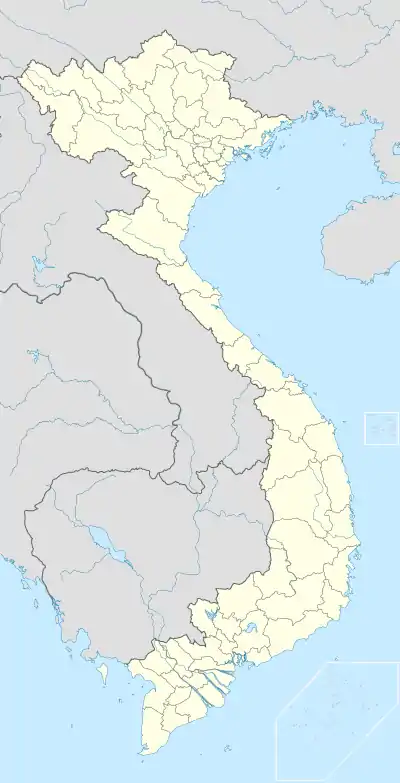Battle of Như Nguyệt River (1077)
The Battle of Như Nguyệt River, also called the Battle of the Cầu River, took place during the final phase of the Song–Vietnamese Border War (1075–1077). The battle occurred along parts of the Cầu River flow through modern-day Bắc Ninh Province, some eight to fourteen kilometres (8.7 miles) northeast of Hanoi, in February 1077. At the battle, the Vietnamese led by admiral-general Lý Thường Kiệt successfully fended off the Chinese's attempt to cross the river, eventually forced the Song to retreat and the war ended with peace negotiation.
| Battle of Như Nguyệt River | |||||||
|---|---|---|---|---|---|---|---|
| Part of Song–Vietnamese war (1075–1077) | |||||||
| |||||||
| Belligerents | |||||||
| Song dynasty |
Dai Viet | ||||||
| Commanders and leaders | |||||||
|
Guo Kui Zhao Jie |
Lý Thường Kiệt Nùng Tông Đản | ||||||
| Strength | |||||||
| 50,000–100,000 soldiers, 200,000 draftees | Unknown, 400 boats | ||||||
 Location in Modern-day Vietnam | |||||||

Location
The Cầu River or the Fuliang River (in Chinese sources such as the Zizhi Tongjian Gangmu) flows through northeast Vietnam is one of the major tributaries to the Red River. It stands as the major natural barrier between the mountainous Sino–Viet borderland and the Red River Delta, the heart of the Vietnamese state. The location of the battle was along with the parts of the river that flow through modern-day Bắc Ninh Province.
Background
By the 1050s, the Vietnamese kingdom Dai Viet under the rule of king Lý Thánh Tông (Lý Nhật Tôn, r. 1055–1072) had rapidly expanded its borders to the north, and subdued many indigenous groups into the mandalas, such as the Nùng and Tày people, and came to have violence border disputes with the Song Empire of China.[1] In 1065, Thánh Tông allied with Nùng leaders Nùng Tông Đản and Lưu Kỷ, which the Chinese saw as threatening to their southern interests.[2]
When Lý Càn Đức (r. 1072–1127) became king of Dai Viet in 1072, border disturbances between the Sung and the Vietnamese escalated into war. In late 1075, to demonstrative against growing Chinese military presences in the border region and also to expand his territories, Lý Càn Đức ordered his regent–general Lý Thường Kiệt to launch an invasion of Southern China. Within three months, the Vietnamese took several fortified towns in Guangxi, butchering 50,000 people in Nanning. The Viet surprised attack provoked Wang Anshi, the chief minister of the Song Empire. Wang urged the Emperor Shenzong (r. 1067–1085) to rally troops from the Tangut frontiers to the south for a counterattack.[3] Although Wang's petition initially was opposed by his conservative oppositions; by September 1076 the Emperor had approved. The expedition comprised an army of approximately 100,000 troops and 200,000 draftees led by generals Guo Kui and Zhao Jie, advanced and retook Nanning and Guangxi in late autumn.[4]
The Song army crossed the southern frontiers in late 1076; Guo Kui commanded the main army marched through Lạng Sơn while Zhao Jie advancing through Cao Bằng plateau to destroy Viet-Nung fighters, then two armies regrouped at the northern bank of the Cầu River in early 1077, waiting for naval reinforcement. To prepare, Lý Thường Kiệt ordered his men to build several lines of ramparts along the southern banks of the River through Bắc Ninh, covered them with thousand of bamboo sticks covered with incendiary mixtures and flammable oil; he also gathered around 400 boats to support the defensive lines.[5] In Hanoi, the king and Buddhist monks opened an assembly to pray to Buddha for a miracle.[6]
Battle
Due to the lack of naval support, the Song army camped in the northern banks had to wait the navy, but tropical malaria and disease have already consumed their manpower. Zhao Xie ordered his loggers cut off trees to construct large pontoon bridges and trebuchets, preparing to cross the river. With constant catapult bombardments, Chinese soldiers assaulted the Viet defensive lines by crossing the pontoon bridges. The Vietnamese burned the bamboo sticks and hold off Chinese attacks, until the Chinese reinforced with more rafts and troops, broke through the Vietnamese lines; some made advanced a maximum of eight kilometres toward Hanoi, but in the end, they were pushed back to the north by the Viets.[7]
Fighting in the Bắc Ninh salients became a stalemate after a month of intense slaughtering as both sides suffered heavy losses. In late February, general Lý Thường Kiệt himself led thousands of troops across the river at night to launch a surprise counterattack on the Song. The Song army was caught off guard and nearly collapsed until Guo Kui turned the tide by releasing his cavalry and elite bodyguard reserves which stripped the Vietnamese war elephants, pushed the Viets to the river banks, and killed two Vietnamese princes. Although had successfully repulsed the Viets' counterattack, the Song army was exhausted, more than half of the army were killed or died of diseases while the monsoon season was about to begin, Guo Kui decided to retreat.[8] Lý Càn Đức then sent a letter to the Song emperor, demand for peace negotiation.[7]
Aftermath
%252C_stone_-_National_Museum_of_Vietnamese_History_-_Hanoi%252C_Vietnam_-_DSC05540.JPG.webp)
As a result of mounting casualties on both sides, Thường Kiệt made peace overtures to the Song in 1077; the Song commander Guo Kui agreed to withdraw his troops but kept five disputed regions of Quảng Nguyên (renamed Shun'anzhou or Thuận Châu), Tư Lang Châu, Môn Châu, Tô Mậu Châu, and Quảng Lăng. These areas now comprise most of modern Vietnam's Cao Bằng Province and Lạng Sơn Province. Đại Việt held control of the Yong, Qin and Lian prefectures.[8]
Minor clashes continued to occur. In the spring of 1077, Song soldiers raided a holy temple and seized an Amitābha sculpture but abandoned it in the forest when as they fled from a Viet ambush. The Buddha was thought to be lost until a fire during the dry season consumed that forest and villagers reported the miracle to the king, and he returned the Buddha statue to Phật Tích temple with great honors.[6] In 1079 the Song arrested and executed the Nùng leader Nùng Trí Xuân while taking his family as hostages.[9] In 1083, Viets attacked Guihua under the pretense of pursuing Nong Zhihui, the brother of Nong Zhigao.[9]
In 1082, after a long period of mutual isolation, King Lý Nhân Tông of Đại Việt returned Yong, Qin, and Lian prefectures back to Song authorities, along with their prisoners of war, and in return Song relinquished its control of four prefectures and the county of Đại Việt, including the Nùng clan's home of Quảng Nguyên.[8] Further negotiations took place from July 6 to August 8, 1084 and were held at Song's Yongping garrison in southern Guangnan, where Đại Việt's Director of Military Personnel Lê Văn Thịnh (fl. 1038–1096) convinced Song to fix the two countries' borders between Quảng Nguyên and Guihua prefectures.[10][11]
The 14th-century Buddhist scripture Thiền uyển tập anh claimed that during his silent preparation for a counterattack in late February 1077, Lý Thường Kiệt incited his troops' morales by making a famous poem, known as the Nam Quốc Sơn Hà.[12]
References
Citations
- Anderson 2008, p. 199–200.
- Anderson 2008, p. 202.
- Taylor 2013, p. 81–82.
- Anderson 2008, p. 208.
- Taylor 2013, p. 83.
- Taylor 2013, p. 86.
- Taylor 2013, p. 84.
- Anderson 2008, p. 209.
- Anderson 2008, p. 210.
- Anderson 2008, p. 209-210.
- Anderson (2008), 210.
- Taylor 2013, p. 85.
References
- Anderson, James A. (2008), ""Treacherous Factions": Shifting Frontier Alliances in the Breakdown of Sino-Vietnamese Relations on the Eve of the 1075 Border War", in Wyatt, D. (ed.), Battlefronts Real and Imagined: War, Border, and Identity in the Chinese Middle Period, Palgrave Macmillan, pp. 191–226
- Taylor, K. W. (2013). A History of the Vietnamese. Cambridge University Press. ISBN 978-0-521-87586-8.